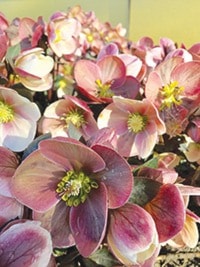A few readers have told me that despite not having a garden anymore, they still enjoy reading the Cultivated column. Thankful for their kind words, I thought I’d take those readers on a tiny tour of south Oak Bay, a plant tour that you might take in your imagination, by foot, or even by car (though a few short steps will add to your delight). We’ll head out to look at flowers in February (lucky us!) and I’ll try to explain as we go why these plants are thriving.
Let’s start at Windsor Park, on the west side of the pavilion where a fabulous patch of hellebores are in full bloom. Hellebores are typically a shade perennial, so why are these huge plummy clumps so healthy?
After a call to Oak Bay Parks horticulturalist Helen Strohschein, I learned that their leaves were trimmed back in January, which means the plant can put its energy into heavy blooms (and you can better see them in all their glory). Secondly, the plants are fed with compost and leaf mulch every year.
As for all that summer light? It’s hot afternoon sun, yes, but this variety is Helleborus x ballardiae ‘HGC Pink Frost,’ a hybrid of H. lividus and the Christmas rose, H. Niger. The first parent is native to Majorca, a dry island in the Mediterranean.
Moving on to the northeast corner of the park, in the new scented garden, a small but interesting shrub is in now bloom. Known as buttercup witch hazel or winter hazel (Corylopsis pauciflora), the plant provides winter interest in semi-shaded locations and will grow to approximately 5x8 ft. Blooming in pale yellow on bare twigs, Corylopsis makes a fine choice for those who find the yellow of Forsythia too glaring or common.
Directly across Windsor Road, on the south side of W & J Wilson, look towards the clipped rosemary hedge, currently blooming blue (just 10 feet inland from Newport). If you’ve tried growing rosemary at home and lost it to cold or damp, note that this rosemary (the robust classic Rosmarinus officionalis) is protected from the rain by the eaves of the building and planted on a south-facing wall. This tender herb likes poor soil and needs drainage. Always treat it (even in a pot) as the sun-lover it is.
Now you’ll have to head south, onto the south block of the two-block-long Linkleas Avenue which is just greening up for spring. This block remains one of the few ‘wild’ lanes in south Oak Bay where native vegetation thrives on the boulevard (though development and invasive plants are threatening that). In the understory, the spring green leaves and drooping white flowers of our native Indian Plum Oemlaria cerasiformis, are out. Their darling upright leaves are so optimistic they make my heart break a little on a grey winter’s day. Indian plum loves seepage areas, so if you’d like a bird-friendly plant, or need a quick-growing deciduous screen in a damp corner of the garden, try it. (I’d be remiss if I didn’t mention that the flowers aren’t particularly pleasant-smelling, so don’t snip them for the vase).
That was quick: four plants and I’ve run out of space! I might make ‘plant tours’ a regular feature of the column as so often I walk my dog and find botanical wonders worth sharing. If you’ve been out in Oak Bay and would like to know the name of a plant, please write to me through my website, cultivatedbychristin.com, and I’ll do my best to investigate. And thanks again to all the retired gardeners reading the column: you inspire me with your attention, knowledge and kindness.
Christin Geall is an avid Oak Bay gardener and creative non-fiction writing teacher at UVic.
